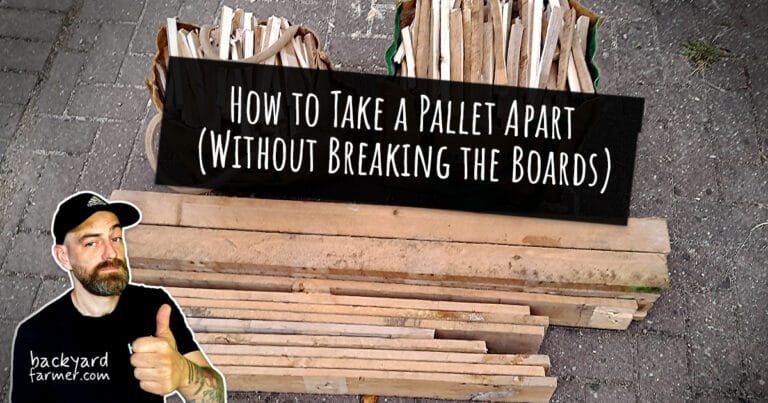Table of contents
How to Take a Pallet Apart (Without Breaking the Boards)
Learning how to take a pallet apart the right way saves time, prevents damage, and gives you a steady supply of strong, reclaimed timber for free. Whether you’re building garden planters, DIY furniture, or a compost bin, knowing the best way to take pallets apart makes every project smoother and far less wasteful.
If you’re ready to start your next project, use my Pallet Finder Tool to locate free or local pallets near you across the UK.
Why It Matters
If you love working with reclaimed pallet wood, you’ll know how important clean, unbroken boards are. Taking a careful approach to dismantling pallets means less waste, stronger results, and a much safer workspace. Plus, every pallet you salvage properly is one less piece of usable wood ending up in landfill.
Common Mistakes
It’s tempting to grab a hammer or pry bar and start pulling, but that’s the quickest way to split boards and waste good timber. The key is patience. With the right pallet take apart tools and technique, you can take apart wood pallets without breaking the boards — leaving you with clean, solid planks ready for your next project.
Pro Tip: Take your time. Gentle, steady pressure always works better than force when dismantling pallets.
What You’ll Learn Here
This guide breaks down the easiest ways to dismantle a pallet, using both hand and power tools. You’ll also learn how to take apart a pallet without power tools, discover which tools to take apart pallets work best, and pick up expert tips that help you work faster, safer, and with cleaner results every time.
Key takeaway: With the right method, you can reclaim high-quality pallet wood without breaking a single board.
Why Take Pallets Apart Carefully
Pallets might look rough and ready, but the timber they’re made from is often high-quality and worth saving. Learning how to take pallets apart properly isn’t just about salvaging wood — it’s about getting the most from a free, sustainable resource that’s perfect for DIY and reclaimed wood projects.
Preserve the Boards for Reuse
Every intact board can be turned into something new — a raised planter, rustic bench, or compost bin. Cracked or split boards limit what you can build, so it pays to take your time. A bit of patience now means more usable reclaimed wood and less waste later on, especially if you’re reusing it for furniture or garden projects.
Tip: Use slow, even pressure when lifting boards. It keeps the wood in better shape and prevents unnecessary splits.
Protect the Nails and Joins
When dismantling pallets, rushing often bends nails or tears through the grain. By easing each board off carefully, you can take apart a pallet without breaking the boards and even reuse nails later. This approach keeps your timber stronger, cleaner, and easier to work with on your next build.
Pro Tip: A small crowbar or pallet breaker tool gives more control and reduces damage at the joins.
Safety and Sustainability
Sharp nails, tight joins, and splinters are all part of pallet work, but slowing down keeps the job safer and smoother. Every pallet you take apart carefully is one less piece of usable timber going to landfill — a small but meaningful step toward more sustainable DIY living.
Did you know? Most heat-treated pallets (marked “HT”) are completely safe for reuse in home or garden projects.
Long-Term Value
If you regularly work with reclaimed wood, learning the best way to take pallets apart is a skill that pays off long-term. You’ll end up with better-quality boards that need less sanding and repair before they’re ready for your next project. Plus, your stockpile of pallet wood stays cleaner, stronger, and ready for whatever DIY idea comes next.
Tools You’ll Need to Take a Pallet Apart
Having the right tools makes all the difference when learning how to take a pallet apart safely and efficiently. You don’t need a full workshop — just a few reliable essentials that help you loosen boards without splitting or breaking them. Choosing the right tools to take apart pallets will save time and keep your reclaimed wood in top condition.
Manual Tools
If you prefer working outdoors or want to take apart a pallet without power tools, hand tools give you more control and help preserve the boards.
- Crowbar or Pry Bar: Ideal for gently levering boards away from the pallet frame without damage.
- Hammer and Mallet: Use a hammer to loosen nails and a rubber mallet for softer pressure when separating boards.
- Nail Punch: Perfect for pushing out stubborn nails without scarring the timber.
- Chisel or Wedge: Great for creating a starting gap before sliding in your pry bar.
These tools require patience, but they’re affordable, durable, and perfect for beginners learning how to dismantle a pallet for DIY or garden use.
Pro Tip: Keep two pry bars handy — a smaller one to start and a longer one for leverage. It makes the process smoother and helps prevent cracks.
Power Tools
If you’ve got access to power tools, you can make the job faster and cleaner — just take care not to damage the boards.
- Reciprocating Saw (Sawzall): Cuts through nails quickly while keeping boards intact.
- Circular Saw: Perfect for trimming damaged edges or removing stubborn sections cleanly.
- Angle Grinder: Excellent for cutting through rusted or tight nails but requires a steady hand.
Power tools make dismantling easier, but always wear safety gear — gloves, goggles, and ear protection — to stay protected while working.
Safety Reminder: Check for hidden nails before cutting. They can dull your blades and cause kickback.
Specialised Pallet Breaker Tool
A pallet breaker tool (also called a pallet buster or deck wrecker) is designed specifically for this task. It slides under the boards and lifts them evenly with two prongs, helping to take apart pallets without breaking the boards. If you work with pallets regularly, this tool is a game changer — saving time, effort, and a fair bit of strain.
Tip: Choose a pallet breaker with a long handle and solid joints. The extra leverage makes dismantling smoother and reduces fatigue, especially when breaking down multiple pallets in one go.
Key takeaway: The right mix of manual tools, power tools, and a pallet breaker ensures you can dismantle pallets efficiently while keeping every board in reusable condition.
Best Ways to Take a Pallet Apart
There’s more than one way to take a pallet apart, and the best method depends on your tools, setup, and the condition of the wood. Below are four of the easiest ways to dismantle pallets — all designed to help you keep every board intact for your next reclaimed wood project.
Method 1 – The Pry Bar Technique
This traditional method relies on patience and leverage rather than power tools. It’s ideal if you want to take apart wood pallets without splitting or damaging the boards.
- Lay the pallet flat on the ground or prop it securely against a wall.
- Start at one end and slide your pry bar gently between the deck board and stringer.
- Wiggle and lift slowly to ease the tension before applying full leverage.
- Move along the board in short sections instead of pulling from one end.
Pro Tip: Tap the board back down lightly between lifts to loosen the nails evenly. It prevents cracking and makes the next lift smoother.
Method 2 – Reciprocating Saw Method
If you have access to power tools, this is the fastest and cleanest way to take pallets apart while keeping the boards in great condition.
- Stand the pallet upright and make sure it’s secure.
- Fit a reciprocating saw (Sawzall) with a metal-cutting blade.
- Slide the blade between the deck board and stringer, cutting through the nails.
- Repeat along each joint until the board lifts free.
This method keeps nearly all the wood intact and leaves only small nail stubs that can be sanded or punched out later. It’s perfect for anyone looking to dismantle a pallet efficiently while protecting the boards.
Key takeaway: The reciprocating saw method is quick, precise, and easy on the timber.
Method 3 – Pallet Breaker Tool Method
A pallet breaker tool (also known as a pallet buster or deck wrecker) is purpose-built for this job and makes the process easier if you dismantle pallets often.
- Slide the dual prongs under the deck board.
- Push down on the handle to lift both sides evenly.
- Work along the pallet to release nails gently and prevent bending or cracking.
This is one of the best tools to take apart pallets — efficient, low-effort, and ideal for frequent pallet recycling or upcycling projects.
Pro Tip: Go for a heavy-duty model with a long handle. The extra leverage makes it easier to take apart a pallet without breaking the boards.
Method 4 – How to Take a Pallet Apart Without Power Tools
If you prefer a quieter, hands-on approach, you can still take a pallet apart without power tools using a few basic items.
- Use a hammer and chisel to create a small gap between the boards.
- Insert a pry bar and lever gently to lift each section.
- Tap nails back through with a punch instead of pulling them out.
Bonus Tip: For stubborn joints, sprinkle a little water over the area. The added moisture softens dry wood and loosens old nails, making it much easier to remove boards without splitting them.
Key takeaway: Working slowly with hand tools gives you more control, preserves your wood, and helps you build skills for future pallet projects.
How to Take a Pallet Apart Without Breaking the Boards
If you want to take apart a pallet without breaking the boards, the secret is patience and control. Working slowly helps you save every piece of reclaimed wood for reuse in DIY pallet projects or garden builds. Whether you’re learning how to take pallets apart for furniture, planters, or compost bins, these steps will keep your boards strong and ready to use.
Work From the Outside In
Start with the outer boards first. They’re easier to loosen and give you better access to the inner nails. Once a few edges are free, the rest of the pallet will come apart more smoothly — a simple trick that saves time and prevents damage.
Pro Tip: Keep a hammer or small pry bar handy to gently separate the first few slats. Once they move, the rest follow much easier.
Apply Even Pressure
When prying boards up, always go slow and steady. Jerky movements or uneven force can cause cracks. If you’re using a pallet breaker tool or crowbar, work evenly along the board — lift one side slightly, then move to the other before returning to the first. This method keeps pressure balanced and helps you take apart wood pallets safely.
Tip: Work your way down the length of the board rather than lifting from one end. This spreads the force evenly and prevents bending.
Loosen Nails Before Lifting
Nails cause most of the breakage when dismantling pallets. To make removal easier:
- Tap boards back down gently with a hammer to loosen nail heads.
- Wiggle the pry bar from both sides before applying leverage.
- Cut through nails with a reciprocating saw if they’re too tight to remove.
These simple steps relieve tension and help you dismantle a pallet without splitting the boards.
Support the Wood
Place a scrap block or offcut under the board as you lift. This gives you a stable base, spreads the pressure evenly, and prevents flexing or snapping. It’s a simple but effective trick for anyone new to taking pallets apart for reclaimed wood.
Key takeaway: Always give your boards support before lifting — it’s the easiest way to avoid splits.
Know When to Stop
Sometimes a board just won’t budge. If it starts to split or bend, don’t force it. Switch tools or come back later with a different method. A patient, methodical approach is always the best way to take pallets apart without losing good timber.
Final Tip: Gentle, even movements and a steady pace protect the boards — giving you cleaner wood for your next project, whether that’s furniture, shelving, or wall cladding.
What to Do with Reclaimed Pallet Wood
Once you’ve learned how to take a pallet apart, you’ll have a stack of strong, character-filled timber ready for a new purpose. Pallet wood is versatile, affordable, and perfect for DIY pallet projects, reclaimed furniture, and sustainable garden builds.
How to Determine If a Wood Pallet Is Safe for Use — this guide explains pallet-markings, treatments (HT vs MB) and what to check before reuse.
Garden and Outdoor Projects
- Raised Beds and Planters: Ideal for herbs, vegetables, or flowers. Pallet boards make it easy to build custom beds suited to your space.
- Compost Bins: A classic upcycling project that’s simple to make and great for recycling garden waste.
- Garden Benches or Tables: Sand, seal, and weatherproof the wood for long-lasting outdoor furniture.
- Tool Racks or Potting Benches: Perfect for organising tools while adding rustic charm to your garden or shed.
These reclaimed pallet wood projects save money and give your garden a personal, handmade feel.
Pro Tip: Always check that the pallet wood is heat-treated (HT) before using it in garden builds to avoid chemical contamination.
Home and Workshop Builds
- Shelving and Wall Storage: Pallet boards bring a rustic, lived-in look to workshops, sheds, or home interiors.
- Coffee Tables and Benches: Combine pallet timber with metal legs for a modern industrial design.
- Feature Walls and Cladding: Mix tones and textures for a warm, reclaimed finish that gives any space a unique feel.
A quick sand and seal transform pallet boards into stylish pallet wood furniture that fits both rustic and contemporary spaces.
Tip: Apply a clear matte varnish or wax to enhance the natural wood grain while keeping that raw reclaimed look.
Craft and Decorative Ideas
- Picture Frames and Signs: Great for small home décor projects or handmade gifts.
- Birdhouses or Insect Hotels: Use untreated pallet boards to create eco-friendly wildlife shelters.
- Candle Holders or Coat Racks: Perfect for using smaller offcuts while adding a cosy, reclaimed touch indoors.
These quick DIY pallet crafts make good use of leftovers and are perfect weekend projects.
Sustainability Angle
Every pallet you reclaim helps reduce waste and supports a more sustainable way of living. Reclaimed pallet wood cuts down demand for new lumber, keeps usable timber out of skips, and gives every board a second life. Learning how to dismantle pallets for wood is a small but powerful step toward eco-friendly DIY living.
For more inspiration on sourcing and reusing scrap materials, check out my full guide on reclaimed materials beyond pallets.
Safety Tips for Dismantling Pallets
Knowing how to take pallets apart safely is just as important as doing it efficiently. Between sharp nails, splinters, and heavy boards, pallet dismantling can quickly turn risky if you’re not prepared. Follow these simple safety tips to make the process smoother, safer, and injury-free.
Wear Protective Gear
Always start with the basics — and don’t skip them:
- Gloves: Protect your hands from splinters, sharp nails, and rough wood while you take apart wood pallets.
- Safety Glasses: Prevent dust, chips, and flying nails from catching you off guard.
- Sturdy Boots: Shield your feet from dropped tools or heavy boards.
- Ear Protection: A must if you’re using loud tools like saws, grinders, or impact drivers.
Pro Tip: It only takes one accident to wish you’d worn protection. Take a minute to gear up before you start.
Check for Treated or Contaminated Wood
Before you take apart a pallet, inspect it carefully. Look for the HT (Heat Treated) stamp — this confirms the wood was heat-treated, not chemically treated. Avoid any pallets marked MB (Methyl Bromide) or those without a visible stamp, as they could be unsafe for indoor or garden projects.
Tip: If the pallet smells odd, feels oily, or shows dark stains, play it safe and find another one.
Create a Safe Working Area
A clear, stable workspace makes a world of difference. Work on a flat, even surface with plenty of space to move freely. Keep tools close at hand and avoid damp or uneven ground where boards might slip. When possible, raise the pallet on sawhorses or a workbench — it’s more comfortable and reduces strain on your back.
Safety Reminder: Good lighting and a clutter-free area help you spot hazards before they cause problems.
Handle Nails with Care
Loose nails are one of the biggest hazards when taking pallets apart. Use a magnet or nail puller to collect them as you go. Always tap down or remove protruding nails before stacking boards. This keeps your workspace tidy and prevents injuries from hidden metal.
Pro Tip: Keep a small container or magnetised tray nearby to collect nails safely as you work.
Take Your Time
When learning how to dismantle a pallet, slow and steady always wins. Rushing causes cracks, splinters, and mistakes. Work methodically from one end to the other, checking for hidden nails and weak points. Spending an extra few minutes per pallet is worth it if it means keeping your wood — and your fingers — intact.
Key takeaway: A patient, organised approach helps you stay safe, work efficiently, and end up with better-quality reclaimed wood for your next project.
FAQs: Taking Pallets Apart
Here are some of the most common questions people ask when learning how to take a pallet apart. These quick, practical answers will help you work smarter, stay safer, and get more usable wood from every pallet you reclaim.
Can you take apart a pallet with an angle grinder?
Yes — but only for cutting through nails. Fit a metal-cutting disc and move carefully along the joins. Avoid grinding too close to the wood, as the heat can scorch or splinter it. Always wear gloves, safety glasses, and ear protection when using power tools.
What’s the easiest way to dismantle a pallet?
The reciprocating saw method is often the best way to take pallets apart quickly and cleanly. It cuts straight through the nails while keeping the boards intact. If you prefer a quieter, manual method, use a pallet breaker tool — it’s efficient, low effort, and helps you take apart wood pallets without splitting them.
What do you call the tool that takes pallets apart?
It’s known as a pallet breaker, pallet buster, or deck wrecker. The dual-pronged design lifts boards evenly, making it one of the most effective tools to take apart pallets without damaging the wood.
How long does it take to take a pallet apart?
That depends on your tools and experience. Using a reciprocating saw or pallet breaker, you can dismantle a pallet in about 10–15 minutes. If you’re using only hand tools, expect around 30–45 minutes per pallet — slower, but ideal if you’re trying to save every board.
Is pallet wood safe to use for indoor projects?
Yes, as long as it’s heat-treated (HT) and free from stains, paint, or oil. Avoid pallets marked MB (Methyl Bromide) — they were chemically treated and aren’t safe for indoor or food-use projects. When in doubt, choose clean, dry, HT-marked pallets.
How should I store reclaimed pallet wood?
Keep your boards stacked flat in a dry, well-ventilated area. Avoid damp ground or direct sunlight, which can cause warping. Before storing, sand rough edges, remove leftover nails, and group boards by size. Properly stored reclaimed pallet wood stays straight, clean, and ready for your next DIY pallet project.
Key takeaway: A bit of care and preparation goes a long way. Safe methods, good tools, and tidy storage keep your reclaimed wood in perfect condition for your next build.
Closing Thoughts
Learning how to dismantle a pallet is one of those small but useful skills that pays off fast. With the right pallet take apart tools, a steady hand, and a bit of patience, you can reclaim quality wood, cut costs, and reduce waste — turning old pallets into something new and sustainable for your home or garden.
Key takeaway: Every pallet you take apart carefully is another step toward a more resourceful and eco-friendly lifestyle.





